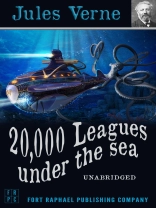Jules Verne’s classic adventure novel ’20, 000 Leagues Under the Sea’ has been hailed as one of the greatest literary achievements in science fiction for over a century.
In this thrilling tale, our narrator – Professor Pierre Aronnax – sets out to explore a series of strange nautical encounters involving a gigantic underwater anomaly…and soon finds himself captured aboard an enormous submarine – the Nautilus – created and piloted by the enigmatic Captain Nemo. Nemo has created the Nautilus for a dual purpose: to escape the treacherous and doomed terrestrial world and to explore the vast depths of the endlessly fascinating ocean. Traveling across the globe and plumbing the deepest seas, the story takes the reader to various exotic underwater locales: from beneath the Arctic ice caps, to the ruins of hundreds of shipwrecks that litter to ocean floor, to the lost empire of Atlantis itself.
While underwater exploration was still in its infancy, Jules Verne imagined a craft that was years before its time. His description of the Nautilus almost exactly mirrors the gigantic submarines that cruise the oceans today. A visionary and brilliant adventure story, ’20, 000 Leagues Under the Sea’ – along with ’Journey to the Center of the Earth’ and ’Around the World in 80 Days’ (to name but two) – is one of a series of Vernes’ Extraordinary Voyages and is one of the finest science fiction novels ever created.
Om författaren
Jules Verne (1828-1905) was born in Nantes, France and was groomed by his father to follow him into the law profession. But Verne felt the strong pull of poetry and literature and, as he studied for his law degree in Paris, he befriended many artists and writers – including the novelist Alexandre Dumas. Upon graduation, Verne remained in Paris and continued to write. Refusing his father’s offer to help him open a law practice in Nantes, Verne took a low-paying job at the Théâtre-Lyrique, where he saw several of his early plays produced. Verne’s life would take a dramatic turn after his introduction to publisher Pierre-Jules Hetzel in 1862. Verne had been working on a novel blending scientific research and adventure fiction and Hetzel strongly encouraged Verne to explore this new genre, publishing Five Weeks in a Balloon in 1863. When the book became a success, Verne signed a contract with Hetzel to produce a new work every year and his subsequent novels – including Journey to the Center of the Earth, From the Earth to the Moon and Twenty Thousand Leagues Under the Sea – would become known as his Extraordinary Voyages and establish Verne as one of the most popular writers in the world. Verne continued to write for the rest of his life but, towards the end, his fiction took a decidedly darker turn. In his last few novels, Verne was writing more about the dangers of technology than celebrating the era’s technological advancements. Verne suffered from diabetes and died at home on March 24, 1905. All told, Verne authored more than sixty books (fifty-four of which comprise his Extraordinary Voyages), as well as dozens of plays, short stories and librettos. His tales have been the subject of countless adaptations for the stage, screen and television. Along with H.G. Wells and Hugo Gernsback, Verne is considered one of the ’Fathers of Science Fiction, ’ and is second only to Agatha Christie as the most translated writer of all time.












